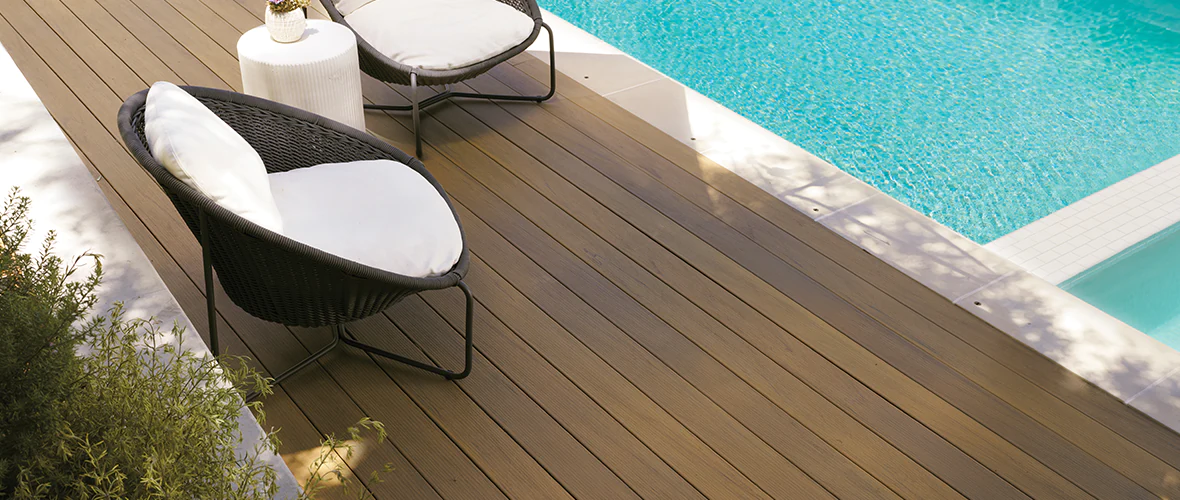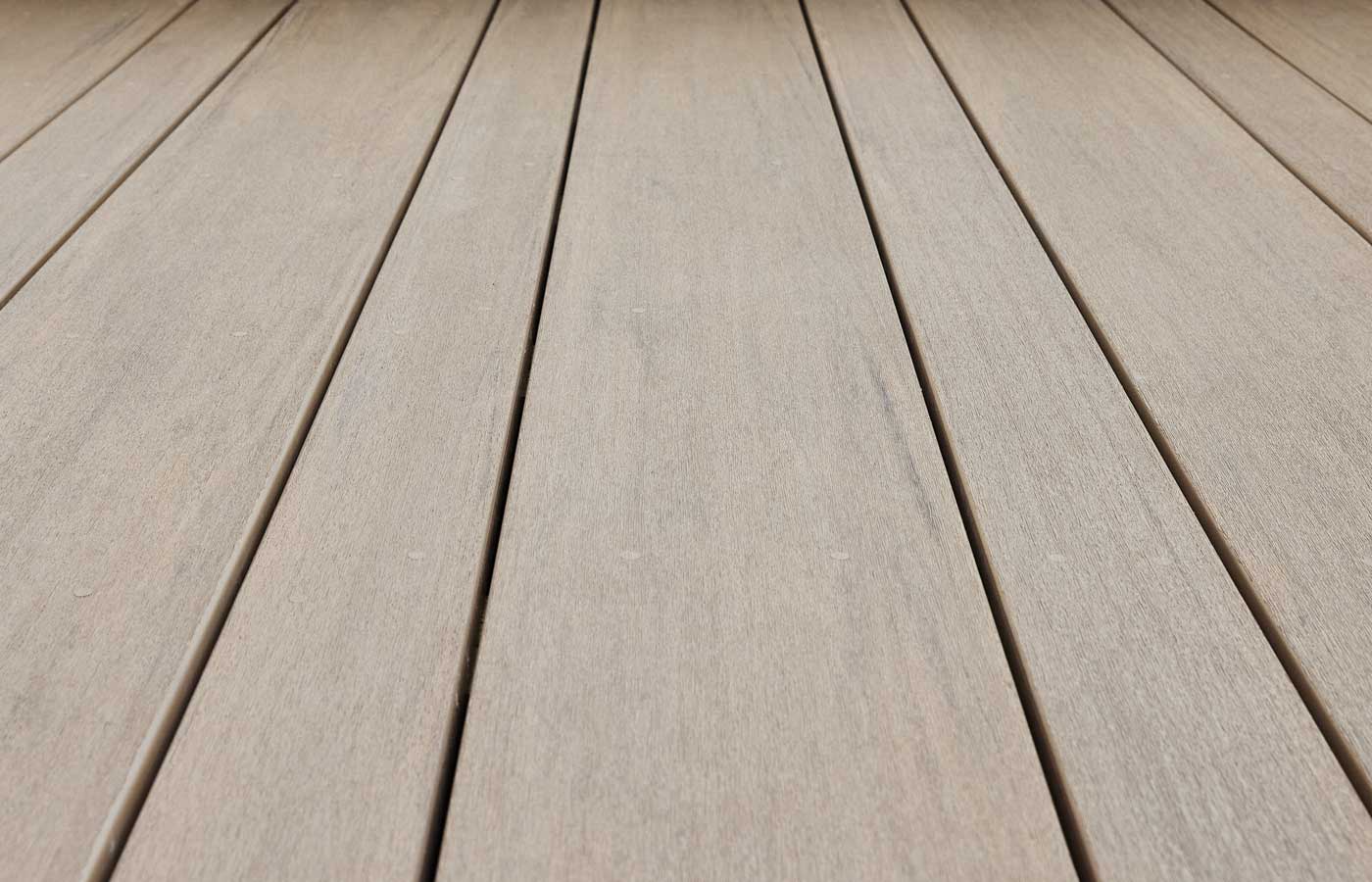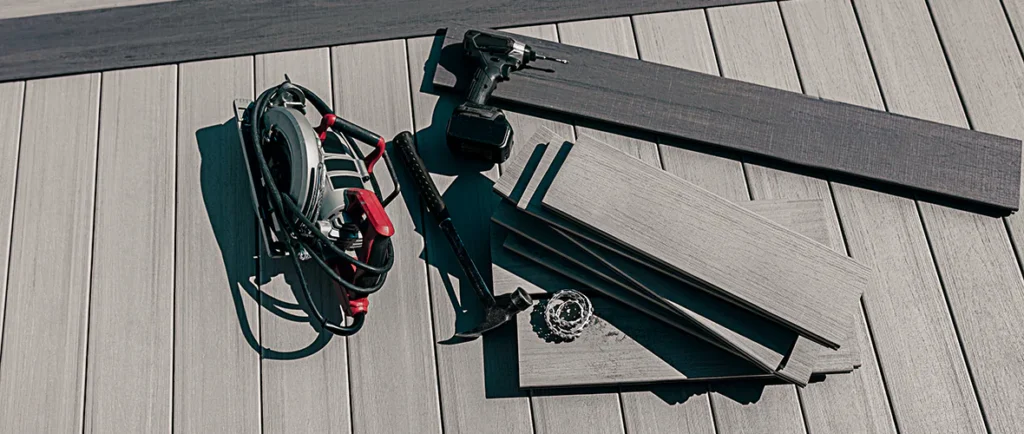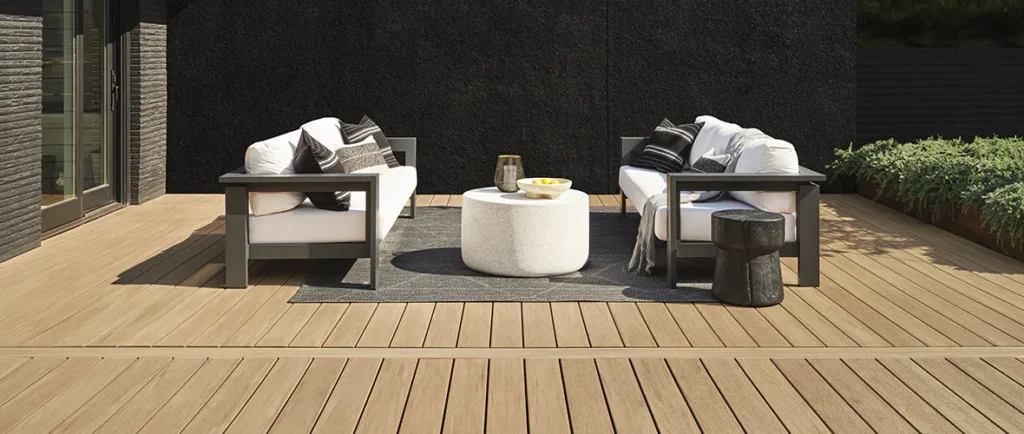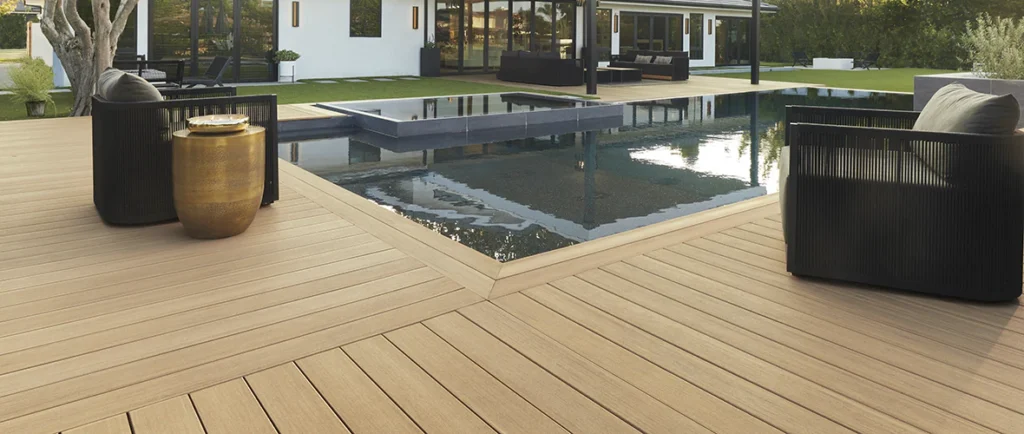If you own a wood deck, you probably dread cleaning before family gatherings or a barbecue. (Not to mention other time- and cost-intensive wood maintenance like sanding, sealing, and staining!) But if you have a composite deck, you probably don’t even bat an eye at the thought of cleaning and maintenance.
Composite decks are engineered to last longer with fewer maintenance requirements. But, as with all finer things, you still need to ensure they withstand the test of time. In other words, you need to learn how to clean composite decking the right way.
The good news is that because of their high-performance design and durable material composition, composite decks don’t need to be sanded or stained for protection, making them less expensive to maintain than wood decks. A composite deck just needs to be periodically cleaned with the right cleaning methods, cleaner, and brush — a safe and straightforward afternoon job when following our cleaning guide.
In this guide, you’ll learn how to properly clean and maintain TimberTech Advanced PVC and Composite Decking in six steps:
- Clear the deck
- Remove debris
- Prepare the cleaner
- Section off the deck
- Clean and rinse the deck
- Dry the deck
Let’s get into it.
Or watch this video:
Step 1: Clear the Deck
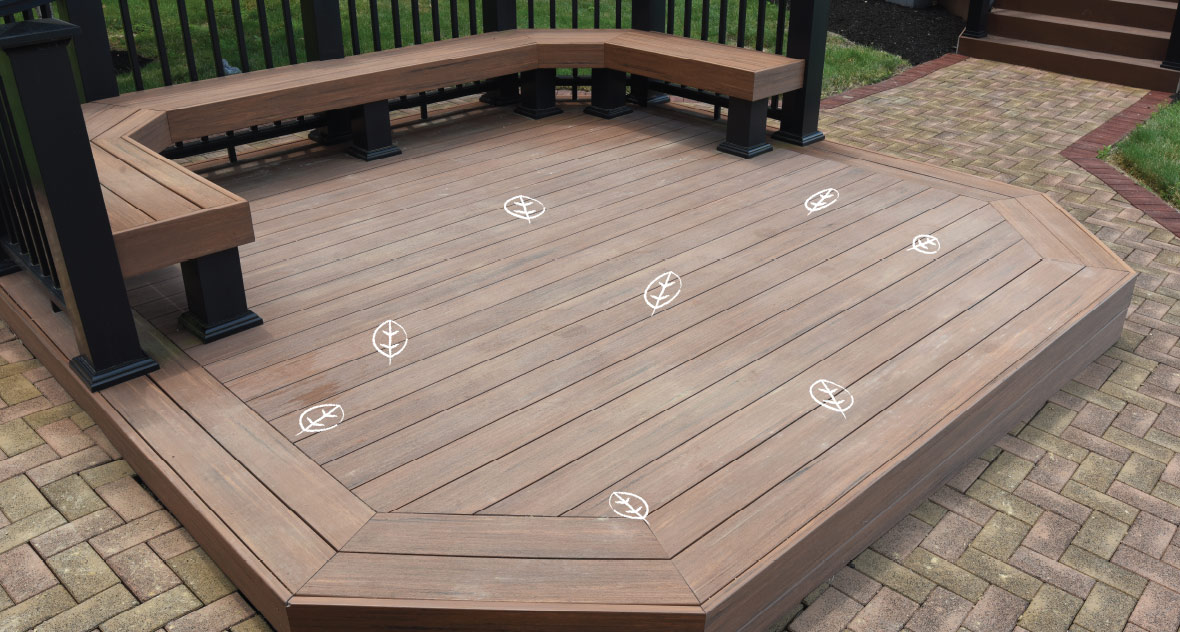
Before cleaning TimberTech Advanced PVC or Composite Decking, you have to first prepare the space. Start by clearing everything, including tables, chairs, and potted plants. This ensures you’ll be able to reach every little spot on your deck. Although this process may take some time, it’s better than having to clean around your furniture. When removing items from the deck surface, be sure to lift and carry them vs. dragging or sliding.
Step 2: Remove debris
Once the deck surface is clear, use a broom or blower to clear away leaves, branches, or other loose debris. Don’t forget to double-check if there’s dirt that needs to be removed from the crevices or corners of your deck.
This is also a good time to cover any immovable nearby plants, or other deck decorations to protect them.
Step 3: Prepare the Cleaner
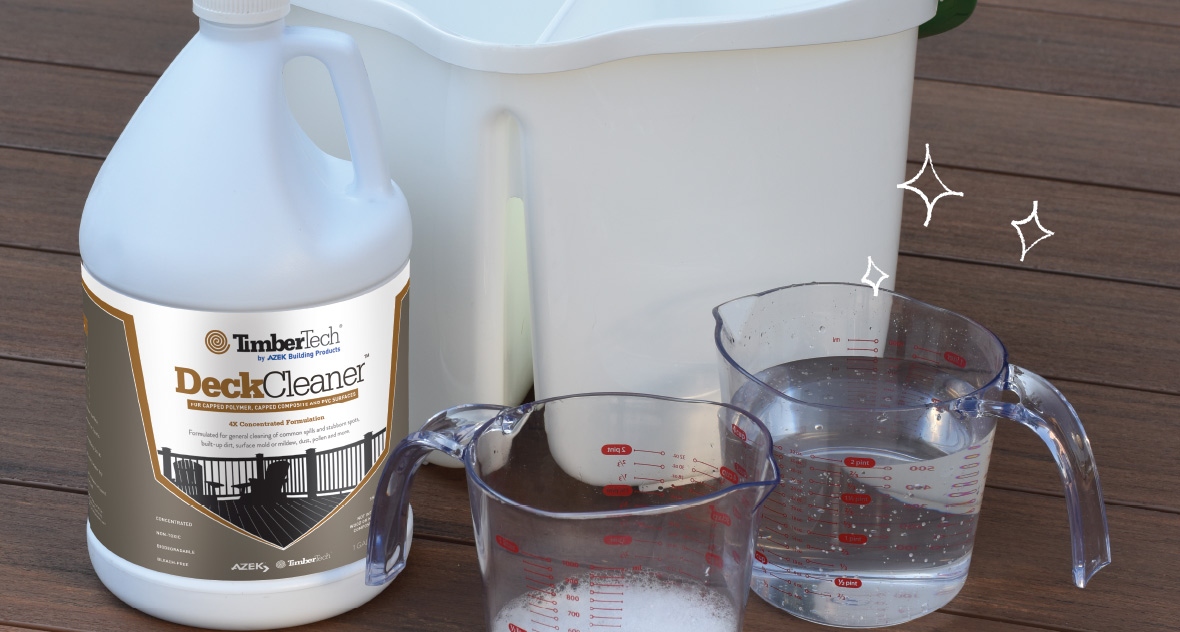
After you’ve cleared the deck, it’s time to get your manufacturer-recommended composite deck cleaner and tools ready.
For the cleaning process, you’ll need:
- TimberTech DeckCleaner or another approved cleaner
- A 5-gallon bucket
- A garden hose with a spray nozzle
- A stiff natural fiber brush for TimberTech Advanced PVC Decking or a medium to stiff nylon brush for TimberTech Composite Decking
- A spray bottle
- A measuring cup
- Cotton terry cloth towels, a sponge mop or a leaf blower
The best way to clean a composite deck is with a cleaning agent specifically designed for your deck material. If you’ll be using the TimberTech® DeckCleaner™, start by shaking it well and diluting it following the instructions on the label. One gallon of diluted cleaner should cover approximately 1,000 square feet of surface area.
It’s also generally safe to use mild soap, such as Wash Safe Spray and Clean Composite Deck Cleaner or Dawn dish soap and water. Before using other cleaners, check with manufacturer for compatibility or effectiveness prior to use.
Step 4: Section Off the Deck
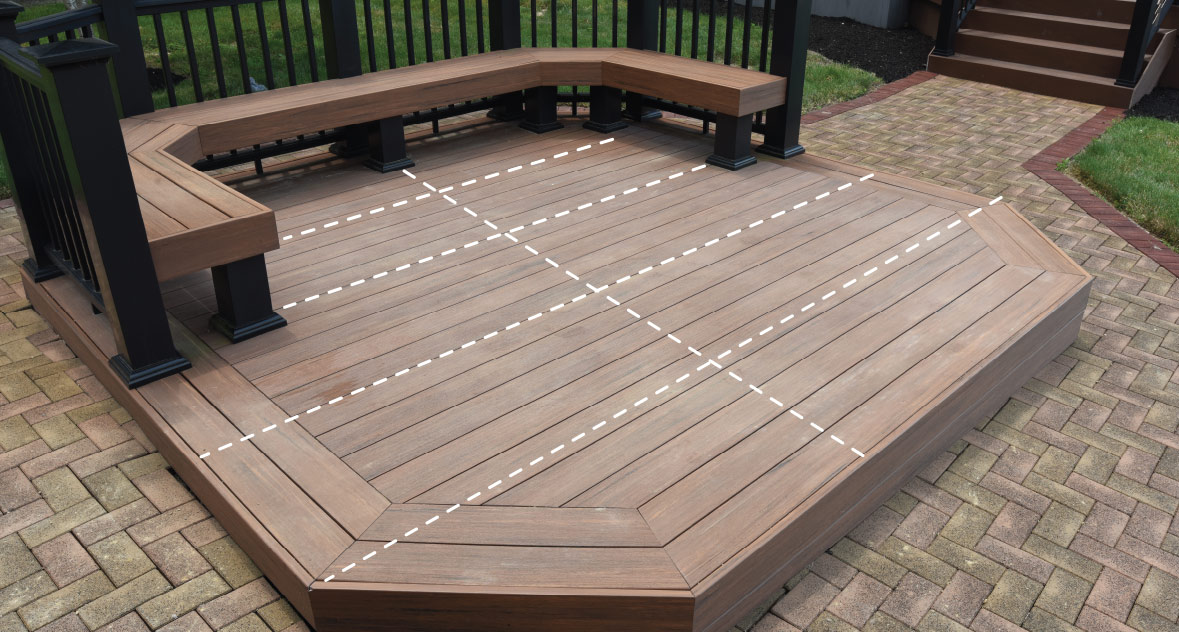
You’ve cleared the deck and prepared your cleaner. Now it’s time to map out where you’ll start cleaning the deck. We recommend cleaning your deck in small sections, working through one area at a time. This will ensure that the cleaning products won’t dry or evaporate before scrubbing.
Saturate the first area you’ll be working on with the diluted cleaner and allow it to stand on the surface for 30-60 seconds. Do not allow the cleaner to dry or evaporate before scrubbing and rinsing, since it will leave a residue that is hard to remove.
Step 5: Clean and Rinse The Composite Deck
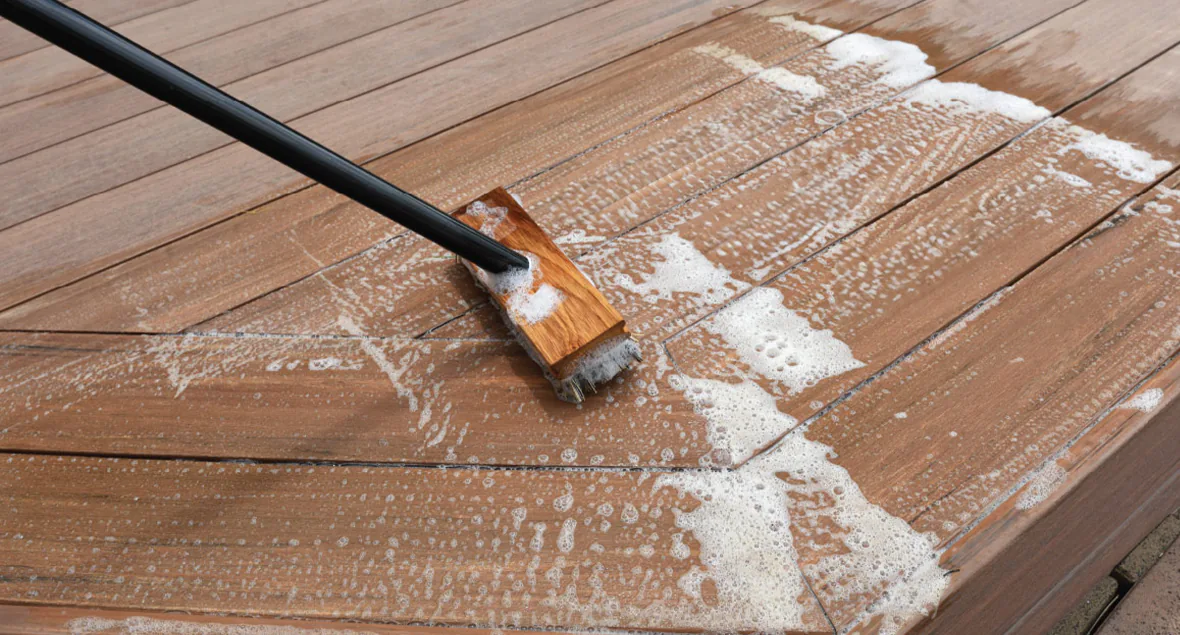
Check deck surface for heavily soiled spots, such as around planters. You may need to spot treat these areas. Start at the end of the deck, working in sections towards an entry or exit point. Be sure to use the recommended brush for your TimberTech deck (a stiff natural fiber brush for TimberTech Advanced PVC Decking or a medium to stiff nylon brush for TimberTech Composite Decking).
Tip: Use a bucket, cleaning spray bottle, towel, or other moveable markers to help identify the manageable areas that you will be cleaning, as you can lose track when deck is wet.
Dip the brush into the bucket with your diluted cleaner mixture, and apply a generous amount to the deck surface. Using firm downward pressure, scrub the decking in both directions, with the grain, and across the grain so that the bristles of the brush are worked into the texture of the deck boards.
Keep your sections wet with cleaner until the area has been completely scrubbed. Be sure to thoroughly rinse immediately after scrubbing. Important: Do not allow any cleaner to dry on the deck surface and avoid splashing cleaner onto nearby areas (like railing or doors).
Aim to rinse in the direction of board grain and length, if possible.
If cleaner does dry to the deck, a white film may occur and you may need to clean again more than once to remove.
Note: a power washer can be used for rinsing only (with a maximum PSI of 1,500 and a fan tip nozzle). Also make sure the power washer is not on the deck surface when in use.
Step 6: Dry the deck
Once you’re done cleaning and rinsing, dry the deck surface to remove any standing water and reveal any spots you might have missed. If spots were missed, spot clean as needed.
Dry the deck using cotton terry cloths, a sponge mop, or a leaf blower, going in the direction of the grain, if possible.
Following these recommendations will provide the best result when cleaning your composite deck
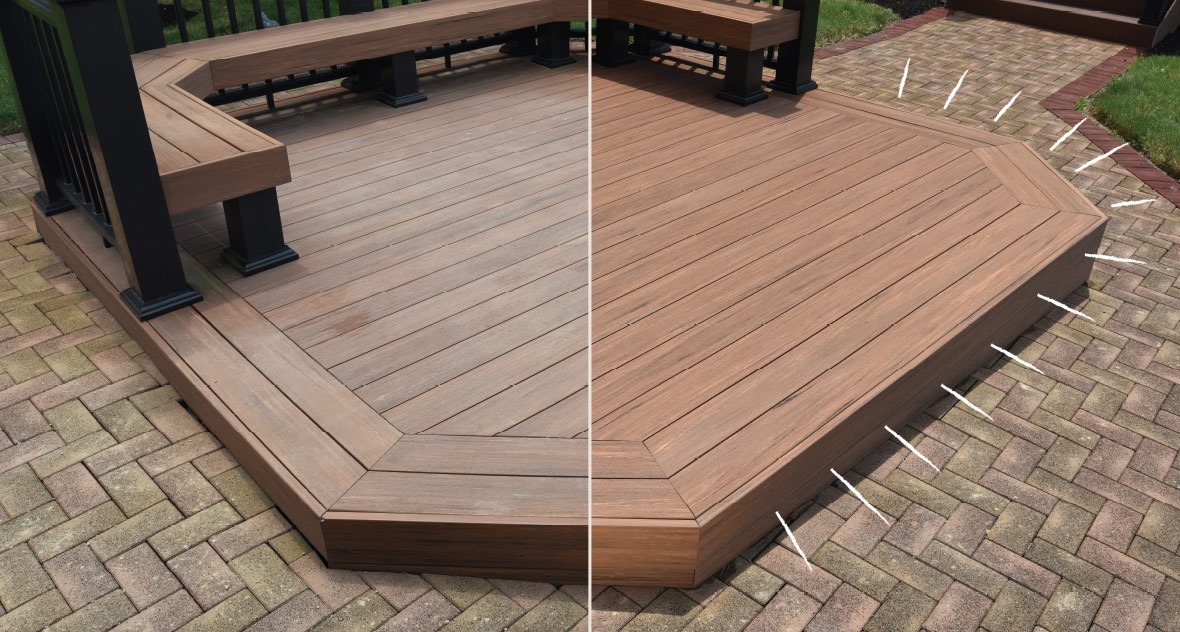
Best Cleaner for Composite Decking by Problem Type
Above all, you need a reliable cleaner for your composite decking. That begins with knowing which material your composite deck is made of — and what needs to be removed from it — so it can be cleaned properly.
It is also very important to use the specified brush type depending on the specific decking material you have. Use a stiff natural fiber brush for TimberTech Advanced PVC Decking and a medium to stiff nylon brush for TimberTech Composite Decking.
How To Keep Composite Decking Looking Like New
- Regularly sweep leaves, debris, dirt, and pollen from the surface
- Spot clean mud, paw prints, and footprints quickly
- Wipe up any spills right away
- Remove mold and mildew as it appears to prevent it from spreading
- Always protect the deck surface while construction, painting, staining, masonry work or similar are being done near the deck.
- Periodically clean your deck, referring to the instructions above
But depending on the type of spill or stain on your deck, you may also use other mild cleaning agents to tackle specific issues like mold, mildew, and rust. However, other factors — such as how long the mess has been there — may affect how to clean composite decking. For chemical related spills or similar concerns, contact the manufacturer for recommendations. For other issues that are not addressed by general cleaning procedures, contact the manufacturer for further assistance.
Before treating issues like this, make sure any cleaning product is safe to use on your composite deck material by checking with the manufacturer’s guidelines for proper cleaning recommendations.
Here’s how to clean composite decking by problem type:
| How To Clean Composite Decking: Common Issues | |
|---|---|
| Stains | Wipe away spills as soon as possible with a dry paper towel. Use a cleaning agent and water or TimberTech® DeckCleaner™ for spot cleaning and tough-to-remove stains. |
| Snow and ice | Remove snow and ice from your deck with a plastic shovel. Do not use metal-tipped shovels, as they can damage your deck surface. |
| Mold and mildew | Rinse the affected area with a cleaning agent and water, and use a deck brush with medium-stiffness nylon bristles to remove the mold or mildew. |
| Oil and grease | Use a paper towel to remove as much as possible. Then, use a compatible de-greasing cleaner followed by a thorough rinse and dry. |
| Dirt and debris | Use a blower or broom regularly to remove loose dirt and debris. Follow cleaning recommendations for general cleaning. |
| Tannins | Tannins are generally caused by wet leaves or stacked wood. Use blower or broom to remove leaves. Then follow guidelines for general cleaning using TimberTech cleaner and brush for your specific deck type. |
If you encounter any hard to clean stains or have an issue not listed above, contact the TimberTech customer service team for assistance. Do not experiment with any unapproved cleaners or solvents.
If you’re still having trouble cleaning your wood deck, consider upgrading to TimberTech composite decking. And with our guide on how to clean composite decking, your deck will be sparkly clean for your next family get-together in no time.
Start your deck project by contacting a TimberTech expert with any questions, then order free samples of TimberTech decking to see the real-wood look of the boards and feel their durable, high-performance materials for yourself.
How To Clean Composite Decking FAQs
If you still have questions on how to clean composite decking, here are answers to some commonly asked questions.
Why Are Composite Decks Easier To Clean?
Composite decks are easier to clean because they are engineered for lower maintenance. This is due to the fully engineered capping that helps lock moisture out, and the all-weather material resists staining and fading.
Can You Use Dish Soap To Clean Composite Decking?
Yes, you can use dish soap to clean composite decking, but you should dilute it in warm water first — thought his will not give you the best results. For best results, use TimberTech Deck Cleaner, the proper brush depending on material type, and follow recommended cleaning procedures.
Can You Power Wash Composite Decking?
Yes, you can power wash composite decking but only for rinsing purposes (no soap involved). To avoid damaging the material, the pressure should be no more than 1,500 PSI using a fan tip nozzle. Keep in mind that pressure washing won’t clean your deck completely. Additionally, keep power washers off your deck surface when in use.
What Is The Best Thing To Clean Composite Decking With?
Follow manufacturers specific recommendations. For TimberTech Decking, use TimberTech Deck Cleaner, the specific brush for your material type, and follow the recommended cleaning procedures.
How Often Do I Need To Clean Composite Decking?
You may clean your deck as needed. We recommend a full-scale cleaning of your composite deck at least twice a year, and when temperatures are above 55 ℉ . Typically, it’s best to clean your deck at the transition of seasons, like from winter to spring and summer to fall.
Remember to contact the manufacturer before trying any chemicals or cleaners on your decking.
